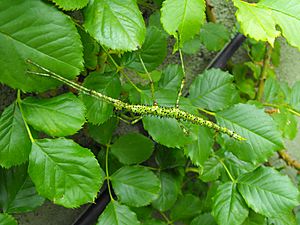Acanthoxyla facts for kids
Quick facts for kids Acanthoxyla |
|
|---|---|
 |
|
| A prickly green stick insect (Acanthoxyla prasina) seen in Fairfield, Otago in 2012 | |
| Scientific classification |
|
| Kingdom: | Animalia |
| Phylum: | Arthropoda |
| Class: | Insecta |
| Order: | Phasmatodea |
| Family: | Phasmatidae |
| Subfamily: | Phasmatinae |
| Genus: | Acanthoxyla Uvarov 1955 |
Acanthoxyla is a special group, or genus, of stick insects. These insects are also known as walking sticks because they look just like twigs or branches! They belong to the family Phasmatidae.
What makes Acanthoxyla unique? Almost all of them are female! These females can reproduce all by themselves. This special way of having babies without a male is called parthenogenesis. It means the eggs develop into new insects without needing to be fertilized.
However, a male Acanthoxyla inermis was recently found in the UK. Scientists think this rare male might have appeared due to a genetic change. The Acanthoxyla group itself came about from different types of stick insects mixing together. This mixing, called hybridisation, led to some groups having three sets of chromosomes (triploid) and others having two sets (diploid).
These fascinating insects are naturally found only in New Zealand. But sometimes, they have accidentally traveled to other parts of the world. The name Acanthoxyla comes from Greek words. "Acantho" means thorn or prickly, and "xyla" means wood or stick. So, their name means "prickly stick," which fits their appearance perfectly!
Contents
About Acanthoxyla Stick Insects
Stick insects are masters of disguise. They blend in perfectly with their surroundings. This helps them hide from predators like birds. Acanthoxyla stick insects are known for their bumpy, twig-like bodies. This makes them look just like the branches they live on.
Amazing Reproduction
Most Acanthoxyla stick insects are female. They reproduce using parthenogenesis. This is a type of asexual reproduction. It means a female can lay eggs that hatch into new insects without a male's help. The offspring are usually exact copies, or clones, of the mother. This is a very efficient way to reproduce. It allows them to increase their numbers quickly.
The discovery of a male Acanthoxyla inermis was very exciting for scientists. It shows that even in species that mostly reproduce asexually, males can sometimes appear. This helps us understand more about how these insects evolve.
Where Do They Live?
Acanthoxyla stick insects are endemic to New Zealand. This means they are only found naturally in New Zealand. They live in forests and gardens, munching on leaves. While they are native to New Zealand, some species have been accidentally introduced to other countries. This usually happens when they hitch a ride on plants or other goods.
Different Kinds of Acanthoxyla
There are several different species within the Acanthoxyla group. Scientists keep track of them to understand their diversity. The Catalogue of Life, which is a big list of all known species, includes these Acanthoxyla species:
- Acanthoxyla fasciata (Hutton, 1899)
- Acanthoxyla geisovii (Kaup, 1866)
- Acanthoxyla huttoni Salmon, 1955
- Acanthoxyla inermis Salmon, 1955
- Acanthoxyla intermedia Salmon, 1955
- Acanthoxyla prasina (Westwood, 1859)
- Acanthoxyla speciosa Salmon, 1955
- Acanthoxyla suteri (Hutton, 1899)
Each of these species has unique features. They might differ slightly in size, color, or the prickliness of their bodies. Studying these differences helps scientists learn more about how these amazing insects adapt to their environments.

